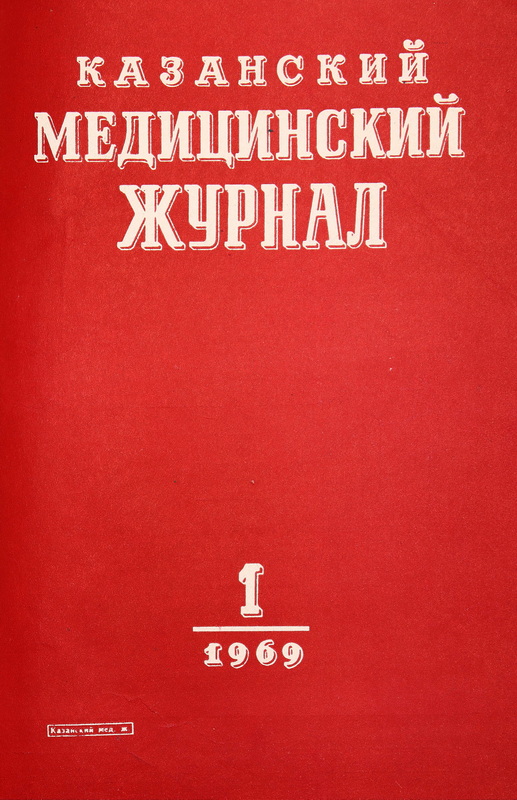Study of the patency of the fallopian tubes during chromopelvioscopy
- Authors: Matsuev A.I.1, Gorovenko N.L.1, Sulitskaya T.D.1
-
Affiliations:
- Kalinin Medical Institute
- Issue: Vol 50, No 1 (1969)
- Pages: 41-43
- Section: Articles
- Submitted: 24.06.2021
- Accepted: 24.06.2021
- Published: 15.01.1969
- URL: https://kazanmedjournal.ru/kazanmedj/article/view/72126
- DOI: https://doi.org/10.17816/kazmj72126
- ID: 72126
Cite item
Full Text
Abstract
The idea of a visual study of the state of the pelvic organs in a woman belongs to D.O. Ott, who in 1901, with the help of special mirrors, carried out such a study for the first time during vaginal abdominal surgery. The author highly appreciated the visual method for examining the pelvic organs in gynecology. In 1903 he wrote: "What was done by touch and blindly before the introduction of this method of illumination is now done under the control of the eye."
Keywords
Full Text
Доложено на заседании Калининского научного общества врачей акушеров-гинекологов 25/1 1968 г.
Идея визуального исследования состояния органов малого таза у женщины принадлежит Д. О. Отту, который в 1901 г. с помощью специальных зеркал впервые осуществил такое исследование во время влагалищного чревосечения. Автор дал высокую оценку визуальному методу исследования тазовых органов в гинекологии. В 1903 г. он писал: «То, что до введения такого метода освещения делалось наощупь и втемную, отныне производится под контролем глаза».
За последние годы интерес к пельвиоскопии в гинекологии возрос [1, 2, 3, 6], к ней чаще стали прибегать при обследовании женщин, страдающих бесплодием [7, 8, 9].
В отечественной литературе мы нашли только единичные сообщения о применении пельвиоскопии для определения состояния маточных труб при бесплодии женщины, чаще она проводилась лишь попутно при исследовании органов малого таза. Это связано, по нашему мнению, с относительной простотой выполнения таких методов определения функционального состояния маточных труб, как пертубация, гидротубация и метросальпингография, которые доступные для широкого круга врачей, в то время как пельвиоскопия может выполняться только квалифицированным специалистом. Между тем пертубация, гидротубация и метросальпингография позволяют установить в большинстве случаев лишь степень проходимости маточных труб и в какой-то мере их функциональное состояние. При пертубации и гидротубации невозможна определить, какая из маточных труб проходима для воздуха или жидкости. Не всегда удается обнаружить наличие перитубарных сращений даже при метросальпингографии. К тому же, прибегая к рентгеновскому исследованию тазовых органов у женщины, не следует забывать об отрицательном воздействии рентгеновых лучей на яичники. Ведь «как бы ни была мала гонадная доза при рентгеновском исследовании, она никогда не бывает равной нулю» [1].
Мы исследовали проходимость маточных труб у 30 женщин, страдающих бесплодием, под визуальным контролем. В возрасте до 25 лет было 3 женщины, 26—30 лет — 18, 31—35 лет—7 и старше — 2; первичное бесплодие было у 14, вторичное — у 16. Пертубация показала частичную проходимость маточных труб (стеноз) у 4 женщин и отсутствие проходимости у 26. Результаты пертубации подтверждены метросаль- пингографией у 4 женщин со стенозом маточных труб и у 12 с отсутствием проходимости труб. У 14 женщин метросальпингография не производилась.
Визуальное исследование проходимости маточных труб (хромопельвиоскопию) мы осуществляем по следующей методике. Накануне кишечник подготавливают как для чревосечения. За 15 мин. перед пельвиоскопией вводят 2 мл 1% раствора (или 1 мл 2% раствора) промедола подкожно. В обычном положении больной на гинекологическом кресле влагалище обрабатывают спиртом. В боковые своды влагалища вводят по 5 мл 0,5% раствора новокаина. После этого женщина самостоятельно принимает коленно-грудное положение. С помощью влагалищного зеркала обнажают задний свод влагалища, который позади шейки по средней линии прокалывают иглой для пункции. При правильном попадании в брюшную полость через иглу засасывается воздух и создается пневмоперитонеум в малом тазу. Дополнительно по игле узким скальпелем (5—6 мм) делают разрез в поперечном направлении заднего свода влагалища и в образованное отверстие вводят троакар. Стилет удаляют и через цилиндр троакара вставляют торакоскоп завода «Красногвардеец».
Оптическая система торакоскопа позволяет произвести общий осмотр тазовых органов. Наиболее часто мы пользовались боковой оптикой. Различная степень васкуляризации тазовых органов создает характерные оттенки при их осмотре. Так, тело матки обычно розовое, яичники — белые, маточные трубы — синюшно-красные, петли кишечника — бледно-синюшные (при отложении в их стенке жировой клетчатки — желтоватые). Спайки имеют вид белесоватых тяжей различной величины и формы.
После первичного осмотра тазовых органов в полость матки через шеечный канал вводят наконечник гидротубатора с манометром [4], который фиксируют в шейке матки эластическим зажимом или двузубцами Мюзо. Под контролируемым по манометру давлением через гидротубатор вводят 5 мл 0,5% раствора новокаина вместе с 5 мл 0,4% стерильного раствора индигокармина. Прохождение жидкости через маточные трубы контролируют визуально с помощью находящегося в малом тазу торакоскопа (рис. 1).
Рис. 1. Визуальный контроль проходимости маточных труб при бесплодии женщин (хромопельвиоскопия). 1 — шнур к трансформатору напряжения; 2 — торакоскоп завода «Красногвардеец», введенный в полость малого таза через задний свод влагалища; 3 — гидротубатор с манометром, наконечник которого введен в полость матки; 4 — шприц 10 мл.
Такая методика позволяет детально изучить состояние маточных труб. В ряде случаев мы наблюдали прохождение жидкости, окрашенной индигокармином, в свободную брюшную полость (у 3), скопление ее в широких перитубарных сращениях (у 5) и сактосальпинксах (у 8). Кроме того, при пельвиоскопии выявлялись кисты яичников, склеро-кистозное их перерождение (у 4) и другие изменения.
У 17 женщин при хромопельвиоскопии был подтвержден поставленный ранее диагноз, у 10 характер поражения маточных труб был уточнен (наличие гидросальпинксов), у 3 первоначальный диагноз был отвергнут. Хорошая проходимость маточных труб отмечена у 3 женщин, частичная — у 5, трубы были непроходимы у 22.
Вскоре после хромопельвиоскопии у 9 женщин с лечебной целью было произведено чревосечение, при котором был подтвержден диагноз, поставленный после хромопельвиоскопии.
Осложнений, связанных с хромопельвиоскопией, мы не отмечали.
Таким образом, хромопельвиоскопия является объективным и ценным методом исследования проходимости маточных труб у женщин, страдающих бесплодием, и может быть рекомендована для более широкого использования ее в клинической практике.
About the authors
A. I. Matsuev
Kalinin Medical Institute
Author for correspondence.
Email: info@eco-vector.com
Department of Obstetrics and Gynecology
Russian Federation, KalininN. L. Gorovenko
Kalinin Medical Institute
Email: info@eco-vector.com
Department of Obstetrics and Gynecology
Russian Federation, KalininT. D. Sulitskaya
Kalinin Medical Institute
Email: info@eco-vector.com
Department of Obstetrics and Gynecology
Russian Federation, KalininReferences
Supplementary files







